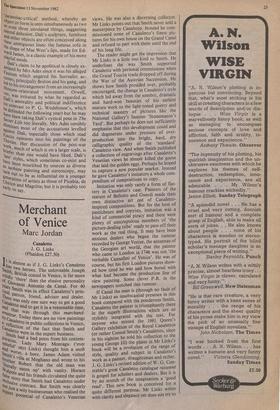Fantasist
Richard Calvocoressi
Salvador Dali
Dawn Ades (Thames & Hudson £7.95, £3.95) Q o much sensational nonsense has been written about Salvador Dali, not least by the artist himself, that it is a relief to come upon Dawn Ades's objective, scholarly monograph. Although she is understand- ably reluctant to undertake what she calls `the type of psychological/sociological analysis that Dali's work seems to beg', she nevertheless goes as far in this direction as it is possible for an art historian well versed in Freud and Krafft-Ebing to go. Reviewing Dali's autobiography The Secret Life in 1944, Orwell concluded that what its author needed was neither unqualified praise for his technical virtuosity nor moral disap- proval of his sick mind, but 'diagnosis'. Mrs Ades avoids both pitfalls and, as one of our foremost historians of Surrealism, is better equipped than most to conduct that investigation into the origins of Dali's `aberrations' which Orwell demanded. She has had access to her subject — a privilege available to few — and her book is par- ticularly revealing about Dali's childhood and formative years before he joined the Surrealist movement in 1929.
Ironically, it was the Surrealists themselves who first voiced moral doubts about aspects of Dali's imagery. But Mrs Ades is careful to distinguish the genuine and deep-rooted from the theatrical and deliberately shocking. Her detailed analysis of Dali's first mature surrealist paintings The First Days of Spring, Dismal Sport, The Great Masturbator, The Enigma of Desire, Illumined Pleasures, Portrait of
Paul Eluard (all of 1929) — is masterly. she explains how Dali's considerable knowledge of psycho-analytical and -pathological literature is combined in these works with, material of a more instinctive and personal nature: adolescent traumas, feelings of sex- ual anxiety and guilt, certain phobias. That Dali was — at least until the intervention of Gala Eluard in his erotic life — a hypersen- sitive individual with a graphic imagination bordering at times on mental derangement is beyond question. Without the help of psychiatry textbooks, his neuroses alight have got the better of his painting. As Mrs Ades points out, he managed instead to ex- ploit 'the iconography of the science 01 psycho-analysis as though it were common property, in the way that religions iconography was common property in the Middle Ages.' The analogy is apt and may go some way towards explaining Dart's phenomenal success, although I suspect the latter has more to do with the seductive stir' face of his pictures, their high degree of precision and finish, and their frequently miniature scale (which suffers little in reproduction). However brutal his disloca- tions and diStortions of nature, Dali's art has atofisramy,palaccaedeinnitlie ictrEaudrtottpoenr
ractS
And yet, one of the most interesting to emerge from this book is that, con trarY
to popular belief, Dali was the most uncif' thodox and independent of all the first generation Surrealists. The possible exelfii: tion to this is Magritte, and there are sign' cant parallels to be drawn in the develop" ment of the two artists' work. Both men r were drawn to Surrealism, and Paris, with a lengthy period of experimenting win modernist styles — Futurism, Cubis Purism — and both kept the company avant-garde poets and intellectuals, 0°10, Catalonia, Magritte in Belgium. Pr..41 graphy and the cinema proves to have b„e another common interest, and as late as autumn of 1927 Dali was promoting th former as the ideal medium for his subv; sion of reality. Mrs Ades is at pains to suit!! his opposition at this stage to the of realists' obsession with the strearn consciousness and various automatic Pr4_ tices. Like Magritte, although less P; saically, Dali's painting was based on objects of the known visible world. Po recognised the unique potential of filnl_y realise, as he put it, 'that unlimited ,fan'
which is born of things themselves. tip
Mrs Ades discusses at some lengwpaii chien Andalou, the extraordinary film and made with Bunuel early in 1929, , to devotes a whole chapter of her book the jlio'srasyubosfeqthueenint unrealised, parnodjechtis:s,,.citc:Iy: laborations with Hitchcock and D's film suggests that what Dali learnt from fitilg and attempted to transfer to his Pain one was the technique of montage, where image dissolves into another, as if under S5, a sudden metamorphosis. This prose of similar to the irrational sequence the
dissociated events experienced
ili
dream, was later refined by Dali into his
Paranoiac-critical' method, whereby an object or form is seen simultaneously as two or even three unrelated things, suggesting mental delusion. Dali's sculpture, furniture and other objects are often conceived along these ambiguous lines: the famous sofa in the shape of Mae West's lips, made for Ed-
ward James, is a classic example of his more Playful mode.
bah's claim to be apolitical is closely ex- rned by Mrs Ades since it was his alleged Fascism which angered his Surrealist ac- e! u,se'rs, principally Breton and his gang, and ueu to his estrangement from an increasingly twi?seow-orientated movement. Orwell, Er, was irritated by what he regarded as li's amorality and political indifference h Contrast to P. G. Wodehouse's, which e defended the following year) but he may have been taking Dali's cynical pose in The Jecret Life too literally. Mrs Ades sensibly dismisses most of the accusations leveled ,gainst Dali, especially those which read ,as.eist opinions into his paintings of the wthirties. Her discussion of the post-war ?rk, much of which is on a larger scale,. is u.riefer than one would have liked. Dali is ,late' styles, which sometimes co-exist and _uave been nourished by sources as diverse tcis tochiste painting and stereoscopy, may urn out to be as influential on a younger generation of artists as those of Picabia, de
".111-1co and Magritte; but it is probably too early to say.















































 Previous page
Previous page